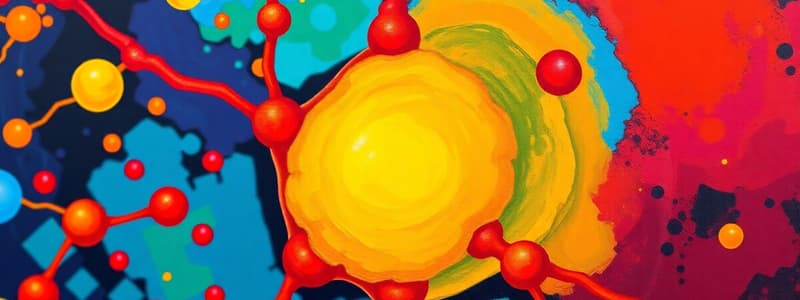Podcast
Questions and Answers
What term describes structures that have one or more nanometer-sized dimensions?
What term describes structures that have one or more nanometer-sized dimensions?
- Massive structures
- Nanomaterials (correct)
- Microstructures
- Supersized materials
Which of the following is NOT an application of nanotechnology?
Which of the following is NOT an application of nanotechnology?
- Medicines
- Turbines (correct)
- Sunscreen
- Furniture
Which type of microscope was developed in the 1930s for viewing nanomaterials?
Which type of microscope was developed in the 1930s for viewing nanomaterials?
- Scanning Electron Microscope
- Optical Microscope
- Electron Microscope (correct)
- Atomic Force Microscope
What is the lower bound of the nanoscale applicable to nanotechnology?
What is the lower bound of the nanoscale applicable to nanotechnology?
Which of the following shapes of nanomaterials is specifically described as having a hollow core?
Which of the following shapes of nanomaterials is specifically described as having a hollow core?
What role did Richard Feynman play in the field of nanoscience?
What role did Richard Feynman play in the field of nanoscience?
What measurement does a nanometer represent?
What measurement does a nanometer represent?
Which type of microscopy uses a mechanical probe to gather surface information?
Which type of microscopy uses a mechanical probe to gather surface information?
What is the primary function of a scanning tunneling microscope?
What is the primary function of a scanning tunneling microscope?
Which fabrication approach involves building products from atomic and molecular components?
Which fabrication approach involves building products from atomic and molecular components?
What is a characteristic of nanomaterials?
What is a characteristic of nanomaterials?
Which method involves writing on a surface using a tip dipped in a chemical fluid?
Which method involves writing on a surface using a tip dipped in a chemical fluid?
Which approach discards excess raw materials to achieve nanoscale sizes?
Which approach discards excess raw materials to achieve nanoscale sizes?
Which of the following is a high-volume practice for constructing nanoscale devices?
Which of the following is a high-volume practice for constructing nanoscale devices?
What potential environmental benefit is associated with nanotechnology?
What potential environmental benefit is associated with nanotechnology?
Which method is utilized to form very pure, high-performance films through chemical reactions?
Which method is utilized to form very pure, high-performance films through chemical reactions?
What characterizes a tropical savanna climate?
What characterizes a tropical savanna climate?
In which latitudinal range is a humid subtropical climate typically found?
In which latitudinal range is a humid subtropical climate typically found?
What is an oceanic climate primarily characterized by?
What is an oceanic climate primarily characterized by?
What typically leads to an energy crisis?
What typically leads to an energy crisis?
Which condition describes a situation where the human population exceeds Earth's carrying capacity?
Which condition describes a situation where the human population exceeds Earth's carrying capacity?
What can contribute to increased electricity costs for consumers?
What can contribute to increased electricity costs for consumers?
What is NOT a characteristic of an energy crisis?
What is NOT a characteristic of an energy crisis?
What environmental issue stems from overconsumption of energy?
What environmental issue stems from overconsumption of energy?
What is a major concern regarding the use of certain substances in medicine and cosmetics?
What is a major concern regarding the use of certain substances in medicine and cosmetics?
Which of the following is considered a primary cause of climate change?
Which of the following is considered a primary cause of climate change?
What is one of the predicted impacts of climate change?
What is one of the predicted impacts of climate change?
What economic concern is associated with climate change?
What economic concern is associated with climate change?
Which gas is primarily emitted from vehicles and poses a poisoning risk?
Which gas is primarily emitted from vehicles and poses a poisoning risk?
What are chlorofluorocarbons (CFCs) known for?
What are chlorofluorocarbons (CFCs) known for?
Which of the following statements about the Filipino climate is correct?
Which of the following statements about the Filipino climate is correct?
What is one of the primary concerns regarding the pervasive distribution of certain substances?
What is one of the primary concerns regarding the pervasive distribution of certain substances?
Flashcards
Open Burning
Open Burning
The burning of materials like paper, trees, and brush, releasing smoke directly into the air.
Fossil Fuel Emission
Fossil Fuel Emission
The release of gases, primarily carbon dioxide, from burning fossil fuels like coal, oil, and natural gas.
Vehicle Emission
Vehicle Emission
The release of gases from vehicles, like carbon monoxide, which is produced by burning gasoline.
CFC Gas
CFC Gas
Signup and view all the flashcards
Climate Change
Climate Change
Signup and view all the flashcards
Tropical Rainforest Climate
Tropical Rainforest Climate
Signup and view all the flashcards
Nano-material Health Concerns
Nano-material Health Concerns
Signup and view all the flashcards
Nano-technology Economic Concerns
Nano-technology Economic Concerns
Signup and view all the flashcards
What is Scanning Tunneling Microscopy?
What is Scanning Tunneling Microscopy?
Signup and view all the flashcards
What is Bottom-Up Fabrication?
What is Bottom-Up Fabrication?
Signup and view all the flashcards
What is Top-Down Fabrication?
What is Top-Down Fabrication?
Signup and view all the flashcards
What is Dip Pen Lithography?
What is Dip Pen Lithography?
Signup and view all the flashcards
What is Self-Assembly?
What is Self-Assembly?
Signup and view all the flashcards
What is Atomic Layer Epitaxy?
What is Atomic Layer Epitaxy?
Signup and view all the flashcards
What is Nanoimprint Lithography?
What is Nanoimprint Lithography?
Signup and view all the flashcards
What is Roll-To-Roll Processing?
What is Roll-To-Roll Processing?
Signup and view all the flashcards
What is Nanoscience and Nanotechnology?
What is Nanoscience and Nanotechnology?
Signup and view all the flashcards
What is Nanoscale?
What is Nanoscale?
Signup and view all the flashcards
What are Nanomaterials?
What are Nanomaterials?
Signup and view all the flashcards
What is an Electron Microscope?
What is an Electron Microscope?
Signup and view all the flashcards
Tropical Savanna Climate
Tropical Savanna Climate
Signup and view all the flashcards
What is a Transmission Electron Microscope (TEM)?
What is a Transmission Electron Microscope (TEM)?
Signup and view all the flashcards
Humid Subtropical Climate
Humid Subtropical Climate
Signup and view all the flashcards
Oceanic Climate
Oceanic Climate
Signup and view all the flashcards
What is a Scanning Electron Microscope (SEM)?
What is a Scanning Electron Microscope (SEM)?
Signup and view all the flashcards
What is an Atomic Force Microscope (AFM)?
What is an Atomic Force Microscope (AFM)?
Signup and view all the flashcards
Energy Crisis
Energy Crisis
Signup and view all the flashcards
What is Nanotechnology?
What is Nanotechnology?
Signup and view all the flashcards
Overconsumption of Energy
Overconsumption of Energy
Signup and view all the flashcards
Overpopulation
Overpopulation
Signup and view all the flashcards
Study Notes
Nanotechnology
- Refers to science, engineering, and technology conducted at the nanoscale.
- Coined by Professor Norio Taniguchi.
- Involves the study and application of exceptionally small things.
- Started in December 1959 by Richard Feynman.
- He discussed a method of directing and controlling individual atoms and molecules.
Nanoscale
- Refers to structures with a length scale applicable to nanotechnology.
- Lower bound to the mesoscopic scale for most solids.
- One nanometer is one billionth of a meter (10⁻⁹ m).
Shapes of Nanomaterials
- Can have one or more nanometer-sized dimensions.
- Examples include particles (spherical, rod-shaped, irregular), tubes (cylindrical), wires (silicon/metal oxides), films (coatings), and flakes (electronics, energy storage).
Viewing Nanomaterials
- Electron Microscopes: Use a beam of electrons to magnify objects up to a million times compared to light microscopes.
- Invented in 1930s by German engineers Ernst Ruska and Max Knoll.
- Two general types of electron microscopes are mentioned: Scanning Electron Microscope and Transmission Electron Microscope.
Atomic Force Microscope (AFM)
- Developed in 1986 by Gerd Binnig, Calvin Quate, and Christoph Gerber.
- A mechanical probe for gathering information from the surface of a material.
Scanning Tunneling Microscope (STM)
- Enables scientists to view and manipulate nanoscale particles, atoms, and small molecules
- Developed in 1986 and won Nobel Prize
Nanomanufacturing
- Refers to scaled-up, reliable, and cost-effective manufacturing of nanoscale materials.
- Enables the development of new products and improved materials.
- Includes research, improvement, and incorporation of processes for the construction of materials.
Fundamental Approaches to Nanomanufacturing
- Bottom-up Fabrication: Builds products from atomic and molecular components
- Additional mentioned approaches include Dip Pen Lithography, Self-Assembly, Chemical Vapor Deposition, Nanoimprint Lithography, Molecular Beam Epitaxy, Roll-to-Roll Processing, and Atomic Layer Epitaxy (in different sections of the text)
Characteristics of Nanomaterials
- Durable
- Stronger
- Scratch-resistant
- Electrically conductive
- Lighter
- Anti-reflective
- Water-repellent
- Antifog
- UV-resistant
- Antimicrobial
- Infrared-resistant
- Self-cleaning
Benefits and Concerns of Nanotechnology (in sections)
- Environment*
- Potential Benefits: Improved detection and removal of contaminants, development of benign industrial processes
- Potential Concerns: High reactivity, toxicity, pervasive distribution, lack of specific EPA regulation.
- Health*
- Potential Benefits: Improved medicine
- Potential Concerns: Ability to cross cell membranes, translocation in the body, lack of FDA approval for certain uses
- Economy*
- Potential Benefits: Better products, new jobs
- Potential Concerns: Redistribution of wealth, potential cost of cleanups and healthcare, accessibility for all income levels
Studying That Suits You
Use AI to generate personalized quizzes and flashcards to suit your learning preferences.




